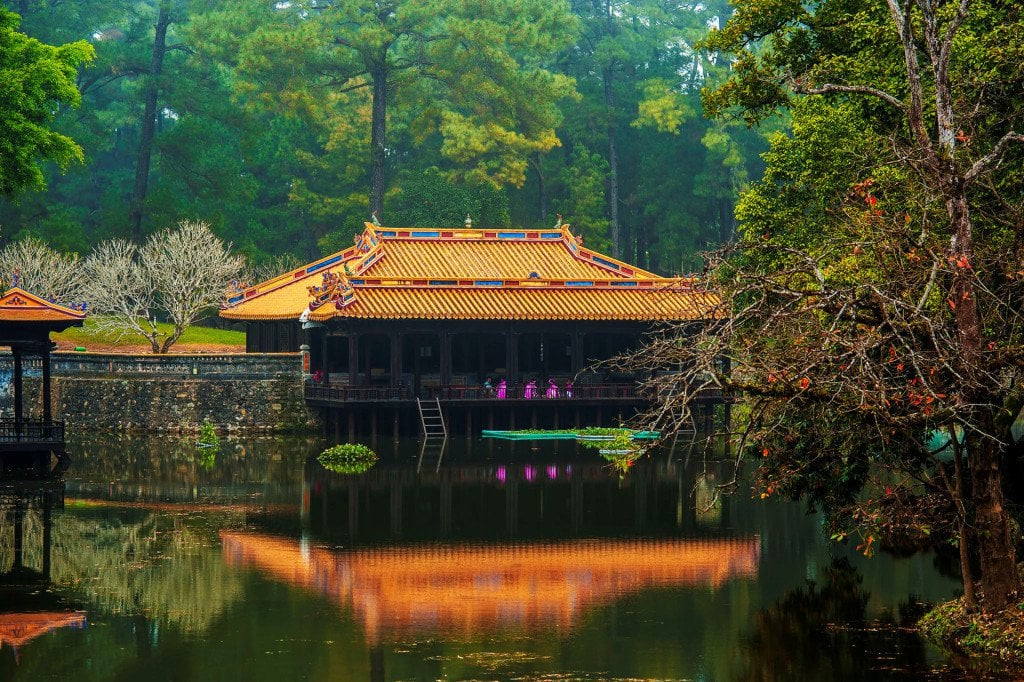Surrounded by green trees and peaceful natural landscapes, the Nguyen Dynasty tombs on the outskirts of Hue attract travelers with their magnificent designs.

The mausoleum of Gia Long, the first Nguyen Dynasty king, reigning 1802-1820, is in Dinh Mon Village of Huong Tra District on the west bank of the Huong (Perfume River), around 20 kilometers from downtown Hue.
The tomb of King Gia Long is quite remote from the Imperial Citadel and tourists can only reach it by boat along the Perfume River. The site is surrounded by green pine trees and lotus ponds that provide escape from bustling life.

He is buried beside Queen Thua Thien Cao who supported the king through many trials and tribulations.
Due to its seclusion, the tomb of King Gia Long is usually overlooked by tourists.

Minh Mang was the second Nguyen ruler, reigning 1820-1839. His tomb is on Cam Khe Mountain, around 12 kilometers from downtown Hue. It took three years (1840-1843) and 10,000 workers and soldiers to complete.
The tomb consists of a palace, shrine and towers arranged in a vertical axis along a 700-meter-long symmetric axis.

The tomb was constructed in 1840 under the reign of King Minh Mang. After his death in 1841, King Thieu Tri continued his father’s wish to complete the mausoleum complex two years later.
Touted as the most majestic of all Nguyen Dynasty tombs, it comprises a complex of 40 structures: palaces, temples, pavilions and shrines. Many have called it a perfect combination of manmade and natural beauty.
It’s not a bad choice to take a boat trip along the Perfume River to reach the tomb besides visiting Thien Mu Pagoda and Hon Chen Temple.

The tomb of Thieu Tri, the third Nguyen Dynasty king, in Huong Thuy District, around eight kilometers from Hue's center, is part of Hue Monuments Complex recognized by UNESCO as a world cultural heritage site in 1993.

Thieu Tri reigned for seven years (1841-1847), passing away in 1847 at the age of 41 due to illness. The king thought his death should not waste too much labor and property and did not build a tomb. After ascending the crown, his son King Tu Duc had geomancers seek a location for this father's burial site. Construction began in 1848 and after 10 months, was complete.
The site is divided into a tomb and temple area.
Like other tombs, Thieu Tri Mausoleum is covered with green spaces and peaceful natural landscapes. In front of the tomb, green trees and rice fields spread from the Perfume River to Lim Bridge.

Tucked under Vong Canh Mountain around seven kilometers from downtown Hue, Khiem Lang, or the Tomb of Modesty, was built in 1864 and took three years to complete. It initially served as a place of repose for King Tu Duc, the fourth Nguyen Dynasty emperor. After he died, it became his resting place.
The tomb of the king is located in the highest area of the complex surrounded by ancient forests. King Tu Duc reigned for over 36 years from 1847, the longest of any Nguyen ruler.

With some 50 structures and surrounded by a 1.5-kilometer-long wall, Tu Duc's tomb reflects the emperor’s romantic nature. In front of the tomb is Giang Khiem Mountain while behind it lies Duong Xuan Mountain. Inside the complex is Luu Khiem Lake where the king used to write poems and read books.

The tomb of King Khai Dinh, located on the slopes of Chau Chu Mountain, is about 10 kilometers from central Hue. It took 11 years to build, starting in 1920. The significant feature of the tomb, which distinguishes it from other royal burial sites in Hue, lies in its subtle blend of Vietnamese and Western architecture. It is said Khai Dinh had construction materials imported from France, Japan and China.
Khai Dinh's tomb is much smaller than other Nguyen rulers'. At the entrance, there are 37 steps leading to the main gate with dragons carved along the walls.

The rear room of Khai Thanh Palace features the main temple, with a statue of Khai Dinh minted in France, his tomb and altar. The most noticeable feature of the tomb are its glass and ceramic mosaics.
King Khai Dinh reigned for nine years from 1916 to 1925.
Source: vnexpress.net
--------------------
Welcome to Viet Center Tourist | Travel agency in Vietnam
An inbound tour operator specializing in providing tour packages in Vietnam, Laos and Cambodia






Leave your comment here!